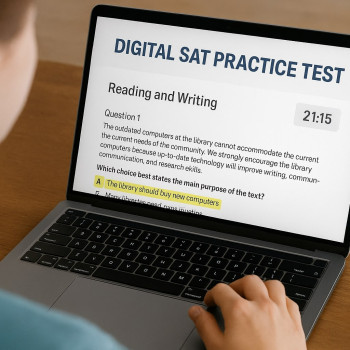So—Do You Need the SAT for University of Toronto? Let’s Start There
Take a breath. If you and your student are wondering whether the University of Toronto (U of T) requires SAT scores, you’re not alone—admissions rules have been changing across the globe in recent years. The short, practical answer: U of T’s published profiles and centralized college-data pages do not list a single, fixed SAT range for all applicants, and their admissions process differs by program and applicant type. What that means for you is: SATs can matter—especially for international and U.S. applicants—but the best move is to understand exactly how they fit into a holistic application for the specific faculty or program you’re targeting.

How University of Toronto Looks at Standardized Tests
University of Toronto reads applications in context. U of T considers transcripts, the rigor of high school courses, personal statements, any required supplementary materials (like portfolios or writing samples for certain programs), and for some applicants, standardized test results. For many international applicants and a number of U.S. applicants, submitting SAT (or ACT) scores remains an option that can strengthen an application—especially when grade scales differ internationally or when the admissions committee wants an additional, comparable data point.
Important practical points:
- U of T’s central admissions and program pages are the final authority—different faculties (e.g., Engineering, Rotman Commerce, Arts & Science) may have different expectations and required supplementary materials.
- Not every program posts a formal SAT range. When a range isn’t listed, that usually means admissions uses a broader, holistic review; strong scores can still help, but they aren’t the only path in.
- Policies can change year-to-year. Always verify the current cycle’s policy on the program’s official admissions page before you apply.
What “Not Listed” or “Not Available” Means on College Profiles
When centralized college directories show “SAT range not available,” it’s usually one of three things:
- The institution doesn’t publish a consolidated SAT band that applies to every program.
- The college receives applicants from many systems (international, provincial, U.S.) and prefers to evaluate on multiple dimensions rather than a single test band.
- The college shifted toward a test-optional or test-flexible posture at some point, leaving score reporting inconsistent between admitted students.
For families, the takeaway is straightforward: don’t let the absence of a published range stop you from preparing. Treat the SAT like a valuable, optional tool: strong scores can differentiate you; mediocre scores won’t help; and a carefully considered decision about whether to submit scores is often the smartest path.
Who Should Consider Taking and Sending the SAT to U of T?
Think strategically about your profile and the story you want to tell in your application. Below are situations where an SAT submission is often helpful:
- International applicants from systems that are hard to compare to Ontario’s high school grading—an SAT gives a consistent benchmark the admissions office understands.
- U.S. applicants who want to demonstrate academic readiness beyond their high school transcript or compensate for a grade dip in a particular term.
- Applicants to highly competitive faculties (such as Engineering, Commerce-focused streams, or certain majors) where extra evidence of quantitative or reading/writing skills can be persuasive.
- Students applying for scholarships or honors programs where test scores can be considered alongside GPA and extracurriculars.
When You Might Skip the SAT
There are also legitimate cases for not sending scores. Consider skipping if:
- Your practice/full-length SAT scores are below your program’s competitive range (if you can find program-specific guidance).
- Your academic record is outstanding and comes from a highly-regarded, rigorous curriculum that U of T already understands well.
- You have strong alternative evidence—national exam results, IB or A-level scores, exceptional achievements, or supplemental materials relevant to the program.
Finding the Right Target SAT Score
The University of Toronto does not publish a single universal SAT cutoff. Instead, build a target based on two lenses: program competitiveness and the broader pool of applicants.
Here’s a practical framework to choose a smart target:
- Ask the program office: some U of T faculties will share typical profiles for admitted students—these conversations are worth it and can save months of worry.
- Compare to peer programs: research similar competitive programs and see the SAT/ACT ranges they list. Use those ranges as a proxy.
- Create a conservative and an aspirational target. Conservative = score that places you safely in the middle of the expected admitted range; aspirational = the score that makes you a clear stand-out.
Example Target Bands (Guiding, Not Absolute)
Because U of T does not publish a single band, families often use general competitive ranges as a guide. Use this table as a planning tool—not a rule.
| Applicant Type | Conservative Target (Digital SAT total) | Aspirational Target (Digital SAT total) |
|---|---|---|
| International (non-Canadian) applicants to competitive programs | 1250–1350 | 1400–1550+ |
| U.S. applicants to competitive programs | 1200–1350 | 1400–1550+ |
| Applicants to highly selective faculties (engineering, commerce-type streams) | 1350–1450 | 1500–1560+ |
Note: These bands are estimates to guide study and application strategy. They reflect how admissions officers typically view competitive ranges across selective North American programs. Always confirm with the specific U of T program office for the most tailored advice.
Digital SAT: What’s Different and How to Prepare
The SAT has moved to a digital format, which changes rhythm, timing, and how you’ll practice. The Digital SAT is adaptive by section and shorter in length, which places an even higher premium on targeted practice and timing strategy.
- Practice on digital platforms—simulate the real test environment so you’re comfortable reading passages and answering questions on a screen.
- Work on pacing: adaptive sections mean early performance influences later question difficulty; the first answers matter.
- Focus on official practice materials and full-length digital practice tests to build endurance and comfort with the interface.
How Sparkl Can Fit In
For many students, a guided approach shortens preparation time and reduces stress. Sparkl’s personalized tutoring adds value here by offering 1-on-1 guidance, tailored study plans that adapt to your digital practice scores, and expert tutors who can teach screen-based strategies for reading dense passages or managing adaptive timing. If your student is balancing schoolwork, extracurriculars, and college applications, getting a tutor who understands the Digital SAT’s quirks can deliver efficient progress.
When to Take the Digital SAT for a Fall Application to U of T
Timing is practical: you want a final, strong score in hand long before application deadlines so you can decide whether to submit it. A typical timeline looks like this:
- Junior year spring/summer: begin focused prep and take at least one full-length practice test to set a baseline.
- Senior year fall (early tests): aim to take the SAT once or twice early in the fall so scores are ready for application review—or so you have time to retake if you want improvement.
- Retake window: schedule a second attempt at least 6–8 weeks after your first real test to allow for targeted practice and noticeable score gains.
Practical Scheduling Checklist
- Check U of T faculty deadlines for the program you’re applying to. Some programs have earlier internal deadlines.
- Allow time for College Board score reporting and processing—factor in extra days if you’re sending international scores.
- If you’re applying for scholarships that consider test scores, confirm scholarship deadlines and whether they use separate timelines.
How to Decide Whether to Send Scores
Once you have one or more official SAT scores, make a calm, evidence-based decision about submitting them to U of T:
- Compare your official score to your conservative and aspirational targets. If you’re comfortably at or above conservative target, sending is usually beneficial.
- Ask the program: certain departments may weigh scores more heavily—if so, prioritize sending.
- Don’t let a single modest score scare you. If other parts of your application are exceptional—unique project work, stellar transcripts, portfolio—admissions reads holistically.
Putting Your Best Application Forward: Beyond the SAT
At a research university like U of T, your application is a mosaic. Test scores are only one tile.
- Transcripts: take the toughest courses available and aim for consistent upward trends where possible.
- Personal statements and optional essays: tell a memorable story. Admissions wants to know who you are beyond numbers.
- Supplementary materials: for programs that ask for writing samples, portfolios, or subject tests, pay close attention to instructions and quality.
- Letters of recommendation: when required or optional, choose recommenders who know you academically and can speak to growth and potential.
Example: A Balanced Application Narrative
Imagine two applicants to a STEM program:
- Applicant A: Very strong school grades with advanced math and science courses, research internship note, SAT = 1320.
- Applicant B: Excellent SAT (1510), strong but slightly less rigorous transcript, notable independent coding project and glowing recommender.
Both tell strong, different stories. U of T admissions will weigh coursework, evidence of interest, and demonstrable achievement. A strategic decision—whether to take the SAT again, emphasize the project, or request additional references—can be guided by counsel (academic counselor or a tutor from a service like Sparkl) and by conversations with the program office.
How to Send Scores & What to Expect
College Board is the official channel for sending digital SAT scores. When you send, make sure you use the correct institution code for University of Toronto and confirm whether the specific faculty requires any additional documentation. Keep in mind:
- Send official scores directly from College Board. U of T typically requires official reporting—not screenshots or unofficial copies.
- If you’re nervous about a lower score, you can weigh whether to send only the highest test (superscore policies vary—confirm current U of T practice for the year you apply).
- Allow enough time for processing so scores arrive before faculty review dates; last-minute reporting creates avoidable stress.
Study Plan: A 12-Week Digital SAT Roadmap
Here’s a practical template families can adapt. This plan assumes about 6–8 hours/week of focused study and more intensive review closer to the test.
| Weeks | Focus | Typical Activities |
|---|---|---|
| 1–2 | Baseline & Timing | Take a full-length digital practice test; analyze strengths/weaknesses; set targets. |
| 3–6 | Skill Work & Strategy | Target weak content areas (math modules, reading strategies); learn adaptive-section timing; 2 practice sections/week. |
| 7–9 | Practice Tests & Review | One full-length digital practice test every 10–12 days; detailed review and error log; targeted mini-lessons. |
| 10–12 | Polish & Test-Day Readiness | Final practice test 7–10 days before test; light review; logistics prep (ID, test center or digital test-day routine). |
Working with a tutor can accelerate this roadmap: a tutor helps set realistic weekly goals, interprets practice-test analytics, and offers on-the-spot strategies for stubborn problem types. Sparkl’s 1-on-1 tutors, for example, build tailored study plans and use performance data to make each session efficient and goal-oriented.
Common Questions Families Ask
Q: If my student has strong IB or A-level results, do they still need the SAT?
A: Often, strong international credentials are sufficient—however, an SAT can still be useful in borderline cases or for scholarship considerations. Reach out to the faculty admissions officer if you’re unsure.
Q: Does U of T superscore the SAT?
A: Superscoring policies evolve. Don’t assume—check with the admissions office for the current cycle’s policy. If you have multiple SATs, an admissions counselor or a tutor can help decide which scores to send based on program norms.
Q: Can SATs help with scholarships at U of T?
A: Some scholarships consider standardized test results among other materials. If you’re applying for internal or external awards, include your strongest evidence—sometimes that includes a high SAT.
Final Practical Checklist for Applicants
- Confirm program-specific admissions requirements on the U of T faculty page—deadlines, supplements, and test policies.
- If you’ll take the Digital SAT, plan early and leave time for a retake.
- Use official digital practice materials and at least two full-length digital tests under timed conditions.
- Consider a tutor if you need structure, accountability, or specialized digital-SAT strategies—personalized coaching can shorten prep time and improve confidence.
- Decide early whether to submit scores. If you do, send official scores from College Board with the correct institution/faculty codes and allow processing time.
- Keep records of submissions and follow up with admissions if you think a score may have been delayed in reporting.

Parting Advice: Be Strategic, Not Stressed
Applying to a world-class university like the University of Toronto can feel overwhelming. Remember that admissions officers want to build diverse classes of curious, capable students. The SAT is a useful instrument in the orchestra of your application—it can amplify your academic strengths when used intentionally, but it doesn’t have to be the soloist.
If you and your student want a tailored path forward—baseline test analysis, a realistic study schedule for the Digital SAT, and practice that mimics the real test environment—consider blending self-study with personalized support. Services that offer 1-on-1 guidance, tailored study plans, and data-driven feedback can make the time you invest far more efficient. Sparkl, for instance, works with students to map a prep plan to their target scores and schedule, pairing them with experienced tutors who focus on strategy, timing, and screen-based test skills.
Next Steps You Can Take Today
- Make a short list of the U of T faculties or programs you’re most interested in and check each program’s admissions page for required materials and deadlines.
- Take a timed digital practice test to set your baseline and discover whether the SAT will meaningfully strengthen your application.
- If your baseline is below your conservative target, set a 12-week study plan (or get a tutor) and schedule a test date that gives you time for a retake.
- Prepare application materials in parallel—strong essays, polished supplementary materials, and timely transcript submissions make a big difference.
Applying to U of T is a journey—one full of choices that you can make deliberately. Use the SAT as the tool it is: a measurable way to show-readiness, not the single definition of your potential. With good planning, the right targets, and thoughtful preparation, your student can present a confident, competitive application.
Good luck—and if you want help turning these steps into a study plan or deciding whether to submit your score, reach out to an admissions counselor or a qualified tutor who can provide one-on-one advice tailored to your student’s profile.














No Comments
Leave a comment Cancel